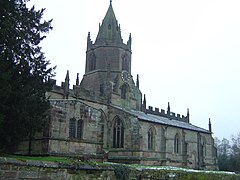Tong, Shropshire
| Tong | |
|---|---|
 St Bartholomew's church, 10 February 2007 |
|
| Tong shown within Shropshire | |
| Population | 243 (2011) |
| OS grid reference | SJ795073 |
| Civil parish |
|
| Unitary authority | |
| Ceremonial county | |
| Region | |
| Country | England |
| Sovereign state | United Kingdom |
| Post town | SHIFNAL |
| Postcode district | TF11 |
| Dialling code | 01952 |
| Police | West Mercia |
| Fire | Shropshire |
| Ambulance | West Midlands |
| EU Parliament | West Midlands |
| UK Parliament | |
Tong is a village and civil parish in Shropshire in England. It is near junction 3 of the M54 motorway (A41) near Albrighton. The population of the civil parish at the 2011 census was 243.
In "White-ladies," one of the "Boscobel Tracts" that describe the events of Charles II's escape from England after the Battle of Worcester, there is a statement that Charles, while sheltering at Boscobel House about two miles away, "had the pleasure of a prospect from Tong to Breewood (sic), which satisfied the eyes, and of the famous bells at Tong, which entertained the ear." The bells he heard were the bells of St. Bartholomew's.
The village is remarkable mainly for its church, St Bartholomews, outside of which is the supposed grave of Little Nell, a fictional character in Charles Dickens book, The Old Curiosity Shop. It is thought that Charles Dickens visited Tong church when his grandmother worked at Tong Castle. The Castle (demolished in 1954) stood to the south; its site is now occupied by the M54 motorway.
The 'grave' is thought to have come about because Charles Dickens' novel was serialised and shipped over to America, and as a result, Americans began coming over to England to visit scenes featured in the book. The tourists recognised the references to Tong church from the book and came to view the supposed 'grave', which of course was not there.
However, a verger and village postmaster, George H Bowden (16 August 1856 - May 1943) apparently asked local people to pay for a headstone, forged an entry in the church register of burials (apparently the giveaway was that he used post office ink to do this), and charged people to see the 'grave'. The headstone has been moved from time to time to make way for genuine graves.
...
Wikipedia

